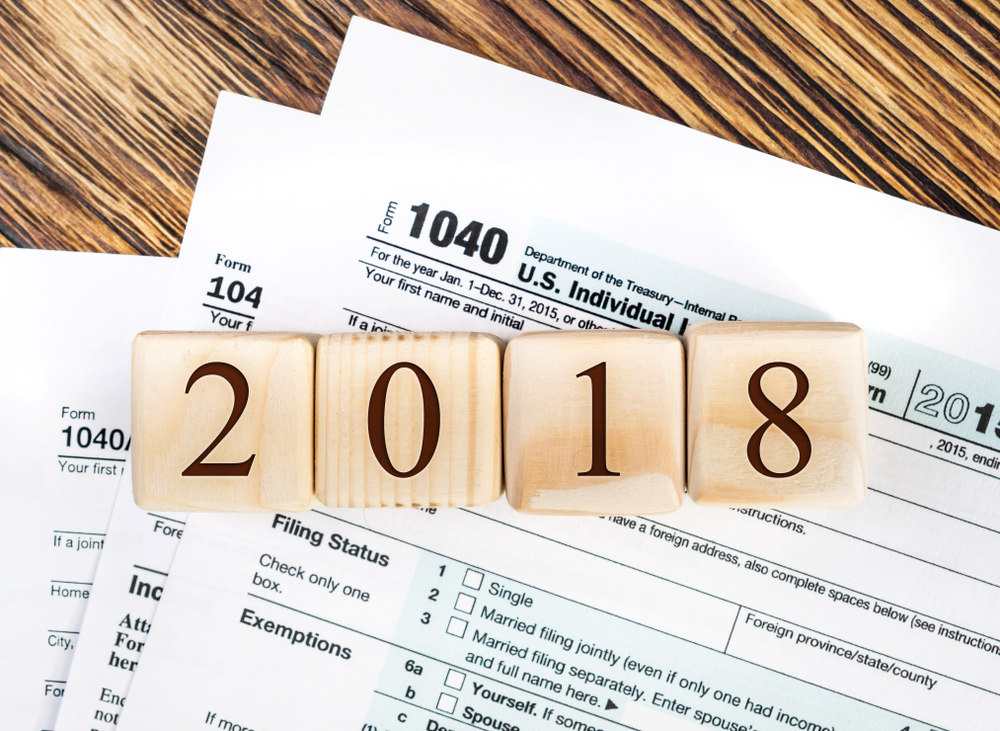
The Major 2018 Federal Tax Changes
Comparing the old rules with the new.
Provided by The Northeast Investment Group
The Tax Cuts and Jobs Act made dramatic changes to federal tax law. It is worth reviewing some of these changes as 2019 approaches and households and businesses refine their income tax strategies.
Income tax brackets have changed. The old 10%, 15%, 25%, 28%, 33%, 35%, and 39.6% brackets have been restructured to 10%, 12%, 22%, 24%, 32%, 35%, and 37%. These new percentages are slated to apply through 2025. Here are the thresholds for these brackets in 2018.1,2
Bracket Single Filers Married Filing Jointly Married Filing Head of Household
or Qualifying Widower Separately
10% $0 – $9,525 $0 – $19,050 $0 – $9,525 $0 – $13,600
12% $9,525 – $38,700 $19,050 – $77,400 $9,525 – $38,700 $13,600 – $51,800
22% $38,700 – $82,500 $77,400 – $165,000 $38,700 – $82,500 $51,800 – $82,500
24% $82,500 – $157,500 $165,000 – $315,000 $82,500 – $157,500 $82,500 – $157,500
32% $157,500 – $200,000 $315,000 – $400,000 $157,500 – $200,000 $157,000 – $200,000
35% $200,000 – $500,000 $400,000 – $600,000 $200,000 – $300,000 $200,000 – $500,000
37% $500,000 and up $600,000 and up $300,000 and up $500,000 and up
The standard deduction has nearly doubled. This compensates for the disappearance of the personal exemption, and it may reduce a taxpayer’s incentive to itemize. The new standard deductions, per filing status:
*Single filer: $12,000 (instead of $6,500)
*Married couples filing separately: $12,000 (instead of $6,500)
*Head of household: $18,000 (instead of $9,350)
*Married couples filing jointly & surviving spouses: $24,000 (instead of $13,000)
The additional standard deduction remains in place. Single filers who are blind, disabled, or aged 65 or older can claim an additional standard deduction of $1,600 this year. Married joint filers are allowed to claim additional standard deductions of $1,300 each for a total additional standard deduction of $2,600 for 2018.2,3
The state and local tax (SALT) deduction now has a $10,000 ceiling. If you live in a state that levies no income tax, or a state with high income tax, this is not a good development. You can now only deduct up to $10,000 of some combination of a) state and local property taxes or b) state and local income taxes or sales taxes per year. Taxes paid or accumulated as a result of business or trade activity are exempt from the $10,000 limit. Incidentally, the SALT deduction limit is just $5,000 for married taxpayers filing separately.1,4
The estate tax exemption is twice what it was. Very few households will pay any death taxes during 2018-25. This year, the estate tax threshold is $11.2 million for individuals and $22.4 million for married couples; these amounts will be indexed for inflation. The top death tax rate stays at 40%.2,4
More taxpayers may find themselves exempt from Alternative Minimum Tax (AMT). The Alternative Minimum Tax was never intended to apply to the middle class – but because it went decades without inflation adjustments, it sometimes did. Thanks to the tax reforms, the AMT exemption amounts are now permanently subject to inflation indexing.
AMT exemption amounts have risen considerably in 2018:
*Single filer or head of household: $70,300 (was $54,300 in 2017)
*Married couples filing separately: $54,700 (was $42,250 in 2017)
*Married couples filing jointly & surviving spouses: $109,400 (was $84,500 in 2017)
These increases are certainly sizable, yet they pale in proportion to the increase in the phase-out thresholds. They are now at $500,000 for individuals and $1 million for joint filers as opposed to respective, prior thresholds of $120,700 and $160,900.2
The Child Tax Credit is now $2,000. This year, as much as $1,400 of it is refundable. Phase-out thresholds for the credit have risen substantially. They are now set at the following modified adjusted gross income (MAGI) levels:
*Single filer or head of household: $200,000 (was $75,000 in 2017)
*Married couples filing separately: $400,000 (was $110,000 in 2017)2
Some itemized deductions are history. The list of disappeared deductions is long and includes the following tax breaks:
*Home equity loan interest deduction
*Moving expenses deduction
*Casualty and theft losses deduction (for most taxpayers)
*Unreimbursed employee expenses deduction
*Subsidized employee parking and transit deduction
*Tax preparation fees deduction
*Investment fees and expenses deduction
*IRA trustee fees (if paid separately)
*Convenience fees for debit and credit card use for federal tax payments
*Home office deduction
*Unreimbursed travel and mileage deduction
Under the conditions set by the reforms, many of these deductions could be absent through 2025.5,6
Many small businesses have the ability to deduct 20% of their earnings. Some fine print accompanies this change. The basic benefit is that business owners whose firms are LLCs, partnerships, S corporations, or sole proprietorships can now deduct 20% of qualified business income*, promoting reduced tax liability. (Trusts, estates, and cooperatives are also eligible for the 20% pass-through deduction.)4,7
Not every pass-through business entity will qualify for this tax break in full, though. Doctors, lawyers, consultants, and owners of other types of professional services businesses meeting the definition of a specified service business* may make enough to enter the phase-out range for the deduction; it starts above $157,500 for single filers and above $315,000 for joint filers. Above these business income thresholds, the deduction for a business other than a specified service business* is capped at 50% of total wages paid or at 25% of total wages paid, plus 2.5% of the cost of tangible depreciable property, whichever amount is larger.4,7
* See H.R. 1 – The Tax Cuts and Jobs Act, Part II—Deduction for Qualified Business Income of Pass-Thru Entities
We now have a 21% flat tax for corporations. Last year, the corporate tax rate was marginally structured with a maximum rate of 35%. While corporations with taxable income of $75,000 or less looked at no more than a 25% marginal rate, more profitable corporations faced a rate of at least 34%. The new 21% flat rate aligns U.S. corporate taxation with the corporate tax treatment in numerous other countries. Only corporations with annual profits of less than $50,000 will see their taxes go up this year, as their rate will move north from 15% to 21%.2,4
The Section 179 deduction and the bonus depreciation allowance have doubled. Business owners who want to deduct the whole cost of an asset in its first year of use will appreciate the new $1 million cap on the Section 179 deduction. In addition, the phaseout threshold rises by $500,000 this year to $2.5 million. The first-year “bonus depreciation deduction” is now set at 100% with a 5-year limit, so a company in 2018 can now write off 100% of qualified property costs through 2022 rather than through a longer period. Please note that bonus depreciation now applies for used equipment as well as new equipment.1,7
Like-kind exchanges are now restricted to real property. Before 2018, 1031 exchanges of capital equipment, patents, domain names, private income contracts, ships, planes, and other miscellaneous forms of personal property were permitted under the Internal Revenue Code. Now, only like-kind exchanges of real property are permitted.7
This may be the final year for the individual health insurance requirement. The Affordable Care Act instituted tax penalties for individual taxpayers who went without health coverage. As a condition of the 2018 tax reforms, no taxpayer will be penalized for a lack of health insurance next year. Adults who do not have qualifying health coverage will face an unchanged I.R.S. individual penalty of $695 this year.1,8
The Northeast Investment Group may be reached at 855-232-6748 or at info@northeastinvestmentgroup.com
